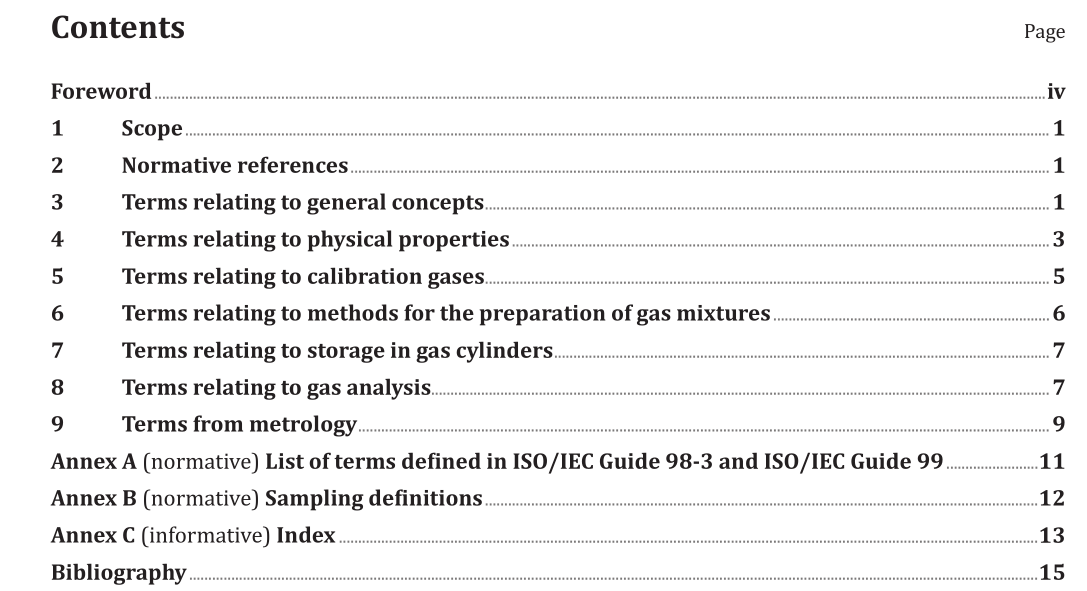ISO 7504:2015 pdf download.Gas analysis — Vocabulary
1 Scope
This International Standard defines terms related to gas analysis, with the main focus on terms related to calibration gas mixtures for use in gas analysis and gas measurements. It does not cover terms which relate only to specific applications.
2 Normative references
The following documents, in whole or in part, are normatively referenced in this document and are indispensable for its application. For dated references, only the edition cited applies. For undated references, the latest edition of the referenced document (including any amendments) applies.
ISO/IEC Guide 98-3:2008, Uncertainty of measurement — Part 3: Guide to the expression of uncertainty in measurement (GUM:1995)
ISO/IEC Guide 99:2007, International vocabulary of metrology — Basic and general concepts and associated terms (VIM)
ISO 10715:1997, Natural gas — Sampling guidelines
3 Terms relating to general concepts
Terms used in the field of gas analysis that are well defined by either ISO/IEC Guide 98-3 or ISO/IEC Guide 99 are included in Annex A.
3.1 homogeneity
state of a gas mixture wherein all of its components (3.3) are distributed uniformly throughout the volume occupied by the gas mixture
3.2 stability
attribute of a gas mixture, under specified conditions, to maintain its composition (3.5) within specified uncertainty (Annex A) limits for a specified period of time (maximum storage life (7.5))
3.3 component
chemical entity at a defined physical state present in a material or in a mixture
3.4 content
amount-of-substance fraction (3.5.1.1), mass fraction (3.5.1.2), volume fraction (3.5.1.3), amount-of-substance concentration (3.5.2.1), mass concentration (3.5.2.2), volume concentration (3.5.2.3) of a component (3.3) in a gas or gas mixture
Note 1 to entry: See ISO 14912 [7] for further information about this concept.
EXAMPLE 1 The hydrogen content in a mixture of hydrogen and nitrogen, expressed as an amount-of-substance fraction (3.5.1.1), is x(H 2 ) = 0,1.
EXAMPLE 2 The content of sulfur dioxide in air at p = 101,325 kPa and T = 288,15 K, expressed as a mass concentration (3.5.2.2), is γ(SO 2 ) = 1 mg/m 3 .
4.6 dew point
temperature at or below which, at a specified pressure, condensation from the gas phase will occur
Note 1 to entry: For pure substances, dew point and bubble point (4.7) coincide. At that temperature, the pressure equals the saturation vapour pressure (4.5).
4.7 bubble point
pressure and temperature condition at which the liquid phase is in equilibrium with the first appearing bubbles of gas
Note 1 to entry: For pure substances, dew point (4.6) and bubble point coincide. At that temperature, the pressure equals the saturation vapour pressure (4.5).
4.8 critical point
single point in pressure-temperature space at which the composition (3.5) and properties of the gas and liquid phases in equilibrium are identical
Note 1 to entry: The pressure at this point is known as the “critical pressure p c ” and the temperature as the “critical temperature T c ”, respectively.
Note 2 to entry: For a pure substance, the critical temperature is that temperature above which only the gas phase can exist irrespective of the applied pressure.
4.9 cricondenbar
maximum pressure at which two-phase separation (condensation) can occur
Note 1 to entry: The phase coordinates cricondenbar and cricondentherm (4.10) apply to gas mixtures (with the binary system as the simplest case). For a gas mixture, the critical point (4.8) is no longer the maximum pressure,as well as the maximum temperature for vapour-liquid coexistence (see Figure 1).
Note 2 to entry: It is the highest pressure in the two-phase envelope and generally higher than the critical pressure.
Note 3 to entry: For a pure substance, cricondentherm (4.10), cricondenbar, and critical point (4.8) are represented by a single point, i.e. the critical point.
ISO 7504:2015 pdf download
